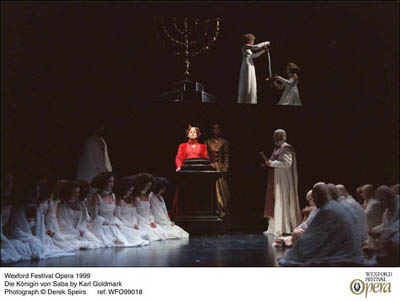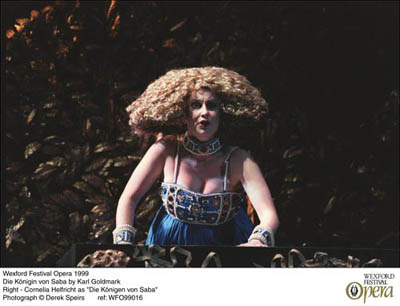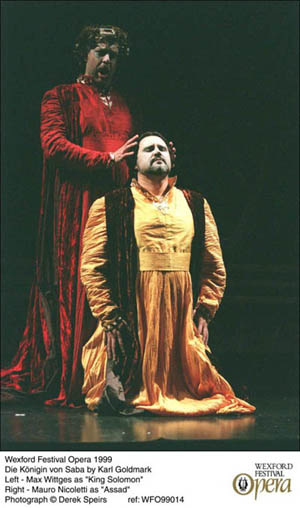|
GLORIES OF WEXFORD

RODERIC DUNNETT reports from the continuing Opera Festival
<< Continued from yesterday
The remainder of the 48th Wexford Opera season served up both visual
spectacle and aural delights: Karl Goldmark's Die Königin von Saba
(The Queen of Sheba) benefited greatly from an imaginatively stylised
staging by Patrick Mailler.  A
few simple gestures, based partly on temple drawings, and almost ritually
repeated (some might say done to death), combined with smoothly sliding
horizontal flats, eloquent moves (particularly those of the King) and some
superb use of static visuals (the Queen of Sheba's prostration before the
enthroned Solomon and his full court was a moment of awesome magnificence). A
few simple gestures, based partly on temple drawings, and almost ritually
repeated (some might say done to death), combined with smoothly sliding
horizontal flats, eloquent moves (particularly those of the King) and some
superb use of static visuals (the Queen of Sheba's prostration before the
enthroned Solomon and his full court was a moment of awesome magnificence).

 Massimo
Gasparon's costumes, with their rewarding cluster of bold colours - scarlet
starkness for the (blind) King Solomon, nasturtium yellow for the fallen
heldentenor hero, Assad, turquoise and blue for the queen and her
handmaiden, stark white for the chorus) produced a Klimtian sumptuousness
to rival Strauss's Salome. By the second, if not the first, night
(when auditorium formalities for the Irish President slightly eclipsed the
visual ceremonies on stage) everything had come together. Conductor Claude
Schnitzler began to reveal some of the magic of a score that might otherwise
have had its longueurs. Massimo
Gasparon's costumes, with their rewarding cluster of bold colours - scarlet
starkness for the (blind) King Solomon, nasturtium yellow for the fallen
heldentenor hero, Assad, turquoise and blue for the queen and her
handmaiden, stark white for the chorus) produced a Klimtian sumptuousness
to rival Strauss's Salome. By the second, if not the first, night
(when auditorium formalities for the Irish President slightly eclipsed the
visual ceremonies on stage) everything had come together. Conductor Claude
Schnitzler began to reveal some of the magic of a score that might otherwise
have had its longueurs.
Max Wittges (a beautifully mellow-voiced baritone for Solomon), Cornelia
Helfricht (vividly alluring in the title role), the superbly acid cutting
voice of Inka Rinn (Sulamith ) and the majesty of Piotr Nowacki (High Priest
- and later Skoluba in the Moniuszko) were among the (vocally and visually)
impressive performers. The smooth, unflappable Baal-Hanaan (Solomon's major-domo)
of Vladimir Glushchak was a piece of cool and carefully plotted acting (as
well as effectively focused singing) which added vastly to this production's
visual impact. Mauro Nicoletti made initial hard work of the opera's Tannhaüser-cum-Dalibor
hero, who falls prey to the Queen and pays the price for their secret amours;
by the second night, and with far better pacing, the slight tedium of the
opening night disappeared and the true beauty of Goldmark's score (which
Hanslick admired and Mahler, no less, conducted, and which grows ever more
darkly chromatic and forward-looking as the later acts are unveiled) began
to emerge.
Wexford's third 'rediscovery' proved not only fascinating and tuneful,
but a rip-roaring audience success (to judge by the cheering and stamping
in the aisles). Moniuszko's Straszny Dwór (The Haunted
Manor) - virtually Poland's national opera, a dazzling example of tunefulness
and wit cloaking a profoundly serious subtext ...
Continue >>
Copyright © Roderic Dunnett, October
24th 1999

Die Königin von Saba is sponsored by Independent
News & Media PLC.
Festival continues till Oct 31 (Box Office : +353 53 22144; Office
: 22400).
The Wexford Festival Opera website, giving detailed information
about this year's operas plus a further selection of colour photos, can
be visited at
www.wexfordopera.com. |
<< Music &
Vision homepage Going Danish >>
|